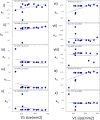Differences in visually induced MEG oscillations reflect differences in deep cortical layer activity
- PMID: 33239652
- PMCID: PMC7688644
- DOI: 10.1038/s42003-020-01438-7
Differences in visually induced MEG oscillations reflect differences in deep cortical layer activity
Abstract
Neural activity is organized at multiple scales, ranging from the cellular to the whole brain level. Connecting neural dynamics at different scales is important for understanding brain pathology. Neurological diseases and disorders arise from interactions between factors that are expressed in multiple scales. Here, we suggest a new way to link microscopic and macroscopic dynamics through combinations of computational models. This exploits results from statistical decision theory and Bayesian inference. To validate our approach, we used two independent MEG datasets. In both, we found that variability in visually induced oscillations recorded from different people in simple visual perception tasks resulted from differences in the level of inhibition specific to deep cortical layers. This suggests differences in feedback to sensory areas and each subject's hypotheses about sensations due to differences in their prior experience. Our approach provides a new link between non-invasive brain imaging data, laminar dynamics and top-down control.
Conflict of interest statement
The authors declare no competing interests.
Figures






Similar articles
-
Surprise About Sensory Event Timing Drives Cortical Transients in the Beta Frequency Band.J Neurosci. 2018 Aug 29;38(35):7600-7610. doi: 10.1523/JNEUROSCI.0307-18.2018. Epub 2018 Jul 20. J Neurosci. 2018. PMID: 30030396 Free PMC article.
-
A detailed theory of thalamic and cortical microcircuits for predictive visual inference.Sci Adv. 2025 Feb 7;11(6):eadr6698. doi: 10.1126/sciadv.adr6698. Epub 2025 Feb 5. Sci Adv. 2025. PMID: 39908384 Free PMC article.
-
Quantitative analysis and biophysically realistic neural modeling of the MEG mu rhythm: rhythmogenesis and modulation of sensory-evoked responses.J Neurophysiol. 2009 Dec;102(6):3554-72. doi: 10.1152/jn.00535.2009. Epub 2009 Oct 7. J Neurophysiol. 2009. PMID: 19812290 Free PMC article.
-
Perceptual inference.Neurosci Biobehav Rev. 2015 Aug;55:375-92. doi: 10.1016/j.neubiorev.2015.05.001. Epub 2015 May 11. Neurosci Biobehav Rev. 2015. PMID: 25976632 Review.
-
Predictions not commands: active inference in the motor system.Brain Struct Funct. 2013 May;218(3):611-43. doi: 10.1007/s00429-012-0475-5. Epub 2012 Nov 6. Brain Struct Funct. 2013. PMID: 23129312 Free PMC article. Review.
Cited by
-
On-scalp magnetocorticography with optically pumped magnetometers: Simulated performance in resolving simultaneous sources.Neuroimage Rep. 2022 Jun;2(2):100093. doi: 10.1016/j.ynirp.2022.100093. Epub 2022 Apr 23. Neuroimage Rep. 2022. PMID: 35692456 Free PMC article.
-
Alpha/beta-gamma decoupling in methylphenidate medicated ADHD patients.Front Neurosci. 2023 Sep 29;17:1267901. doi: 10.3389/fnins.2023.1267901. eCollection 2023. Front Neurosci. 2023. PMID: 37841679 Free PMC article.
-
Cytoelectric coupling: Electric fields sculpt neural activity and "tune" the brain's infrastructure.Prog Neurobiol. 2023 Jul;226:102465. doi: 10.1016/j.pneurobio.2023.102465. Epub 2023 May 18. Prog Neurobiol. 2023. PMID: 37210066 Free PMC article.
-
Inferring laminar origins of MEG signals with optically pumped magnetometers (OPMs): A simulation study.Imaging Neurosci (Camb). 2025 Jan 2;3:imag_a_00410. doi: 10.1162/imag_a_00410. eCollection 2025. Imaging Neurosci (Camb). 2025. PMID: 40800772 Free PMC article.
References
Publication types
MeSH terms
Grants and funding
LinkOut - more resources
Full Text Sources

